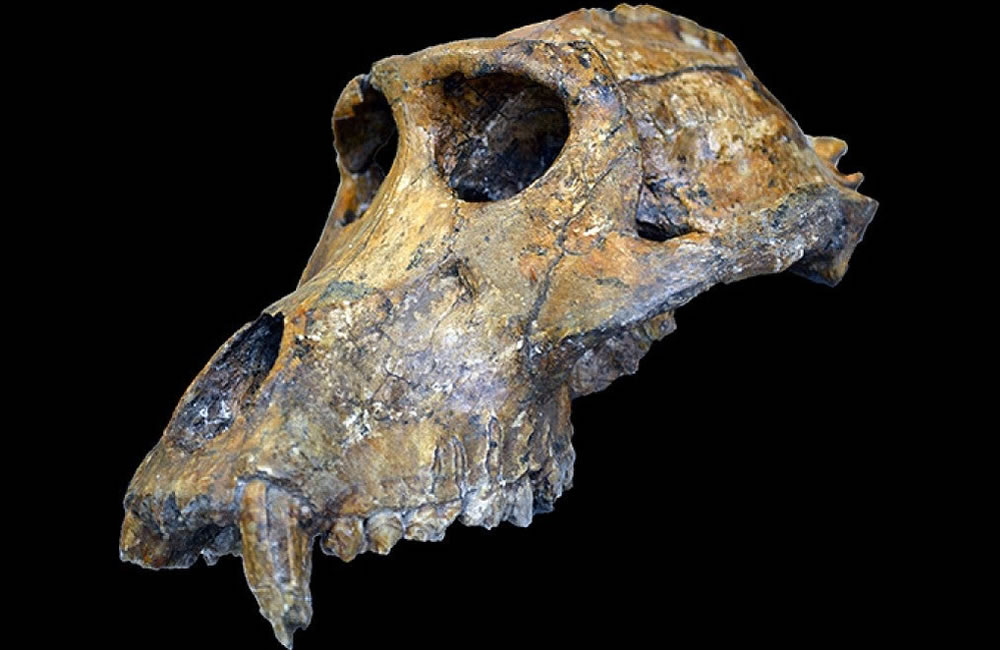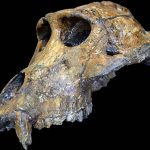Africa is a primo place to go if you’re hunting fossils, the primate kind and otherwise. South Africa, Ethiopia, Egypt, and Kenya are prime fossil hunting grounds since the landscape tends to be dry with little vegetation, making the ground highly exposed and the digging relatively easy. Though most fossils from the most primitive primates have been found in North America and Europe, a few specimens have been found in Africa, including Anchomomys, Djebelemur, Aframonius, and Wadilemur. (Funny names, seriously primates.) Dwelling in Africa during the Eocene (~55-33 million years ago), these primates would have reminded you a little of a lemur and are considered to be of the cercamoniine radiation. (For more about the “cercs,” read the Fossils of Asia.) In addition to these prosimian-like primates, there were also monkey-like primates dwelling in Africa during the Eocene. Known as the Parapithecids, these primates are considered somewhat primitive to the monkeys we now have in Africa, but instead resemble New World monkeys in regard to their tooth arrangements and skull shapes.
A little later in time, during the early Oligocene, specimens from another primitive group of monkeys, the Propliopithecids begin turning up in the fossil record. One member of this group, Aegyptopithecus zeuxis (seen to the left), was large in body size (about 15 pounds) and had a skull with features similar to anthropoids but still housing a smaller brain, like a prosimian. Other types of primates are present as well, including Afrotarsius chatrathi, whose fossils appear in the Oligocene Fayum of Egypt. As their scientific name implies, these organisms resemble modern-day tarsiers, but also look a little bit like some of the early anthropoid primates. Hopefully, more of these specimens will be discovered to help us better understand how living tarsiers are related to other primates. Throughout the Oligocene, primates tend to be well-represented in Africa, and we can see that as time progresses, these monkeys begin to look more and more like modern-day anthropoids.
As was discussed in the North America section, apes began to take over the planet during the late Oligocene and early Miocene. Africa has a rich fossil record full of primitive and more advanced apes. Most of these apes were eating diets rich with fruit and supplemented with leaves and probably were moving around through the forest both quadrupedally (on all fours) and through the use of arm-swinging. Other types of fossilized specimens begin to pop up in Africa’s fossil record during the Miocene as well, such as primates that can be grouped with modern-day lorises and bushbabies. Mioeuoticus, Komba, and Progalago come complete with tooth combs and were bouncing around in Africa during the Miocene. The first fossils that look almost identical to modern day African monkeys also begin to appear in the Miocene. These monkeys tended to be less common than they are now, probably due to the overwhelming success of ape populations during that same time period.
Moving into the next epoch, the Pliocene (~2-5 million years ago), the primate fossil record in Africa begins to get incredibly interesting as fossils from Ardipithecus, Autstralopithecus, and Paranthropus begin appearing. Most likely eating a diet of rough plant matter, these primates were about chimpanzee size and shared many features with apes, with one important exception—bipedalism. The ability to walk upright places them in a unique category known as Hominidae, though they are missing the large brains, slow growth rates, and uniquely shaped foot that characterize other hominids, such as ourselves. These features gradually appear in the fossil record during the Pleistocene epoch (~1.7 million years ago), as several members from the genus Homo emerges, with Homo sapiens gradually spreading to virtually every degree of the globe.
Safe to say, the rocking horse people were definitely eating some marshmallow pies on the day Lucy (Australopithecus afarensis) was discovered by Donald Johanson and Tom Gray. Found on the side of a ravine in northern Ethiopia in 1974, Lucy is the most complete ancient hominid found to date, meaning that about 40% of her bones were recovered. We know she is indeed a “she” based on the size and shape of her pelvis and her overall small body size (about 60 pounds). And where did Lucy’s name come from? Apparently, scientists digging up fossils in Africa in the 70s were just as fond of the Beatles as everyone else around the world, and when someone suggested the new discovery be dubbed “Lucy” from Lucy in the Sky with Diamonds, everyone thought it was a smashing idea!


